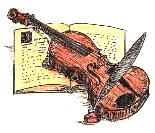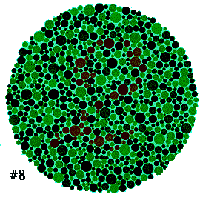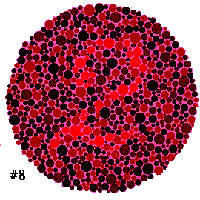 |
Discovering and Developing Talents © 2002 Stephen Holland HiddenTalents.org |
1 - Explaining Color Deficiency 2 - Traditional Tests 3 - Holland's Online Tests 4 - Percent Test 5 - Brown Test - Results 6 - Color Pencils- Results 7 - Art Test 8 - Thread Test for Children |
| 2. Traditional Color Deficiency Tests The best source for purchasing official tests that I have found is Richmond products. |
| Dvorine Pseudoisochromatic Plates The Dvorine Pseudoisochromatic Plates are reportedly more accurate tests than the Ishara plate. |
Farnsworth-Munsell 100 Hue Test An excellent test is the Farnsworth-Munsell
100 Hue Test which gives a person many colored
caps with slight variations of colors, and
asks him to sort colors that are very close together. However, it
is slow and expensive to administer by a
specialist, and is not common. An excellent test is the Farnsworth-Munsell
100 Hue Test which gives a person many colored
caps with slight variations of colors, and
asks him to sort colors that are very close together. However, it
is slow and expensive to administer by a
specialist, and is not common. A company involved with color, such as textiles, dyes, electronics, art work, etc. would be wise to buy the test for its own employees. The test apparatus (left) only costs a few hundred dollars. There is also a simpler D-15 test with only 15 colors, but the bigger test would be better for companies that work a lot with color. |
Anomaloscope  The best color perception test is the anomaloscope. It involves changing the brightness of red and green
lights to match a "standard yellow." The Nigel Anomaloscope is an example. Again,
the tests are expensive and need a specialist
to do properly, but they give exact measurements
of red and green problems. The best color perception test is the anomaloscope. It involves changing the brightness of red and green
lights to match a "standard yellow." The Nigel Anomaloscope is an example. Again,
the tests are expensive and need a specialist
to do properly, but they give exact measurements
of red and green problems.To quote the 1998 New Zealand Health Technology Assessment (NZHTA) analysis of colorblind tests, "-------- "The anomaloscopes are regarded as the gold standard test for impaired vision on the red-green axis and are therefore used for diagnostic purposes." |
| Some More Links for Tests An excellent scientific critique of color deficiency tests is the 1998 New Zealand Health Technology Assessment (NZHTA) Many official tests can be purchased at Richmond Products. A Poster for testing young children, by Golden Retrieval, Inc. Looks interesting. |


